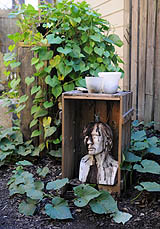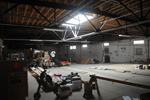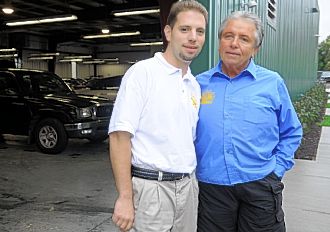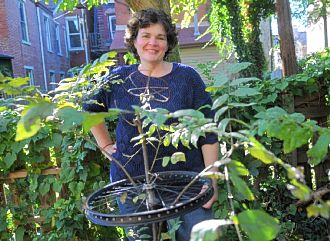
Category Archive: Education
-
Artist’s Eclectic Space on the North Side Combines Found Art, Plants and Her Vision
Saturday, October 16, 2010By Mary Thomas, Pittsburgh Post-GazetteNever overlook the potential of a small lot.
Pittsburgh artist Rose Clancy’s 22-by 90-foot space in the North Side’s Mexican War Streets neighborhood is much more than a garden. It’s also an art installation, autobiography, environmental statement, archaeological dig and strategy for building community.
GardenLab@516 began humbly but, as gardens do, it grew. Ms. Clancy had purchased a dozen past-their-prime white baking potatoes that were beginning to sprout in a supermarket to conduct growth experiments on. When they outlasted the original project, she decided they deserved to continue.
“I admired the potatoes’ will to survive and go to the smallest bit of light and to grow,” Ms. Clancy said.
She asked Mattress Factory museum co-directors Michael Olijnyk and Barbara Luderowski whether there was a spot among the Sampsonia Way properties adjacent to the North Side museum for the plants, and she was offered a vacant lot next to an empty home fronted by a long-term Mattress Factory-sponsored installation by artist Ruth Stanford, “In the Dwelling-House.”

This plaster bust, created by Rose Clancy's mother while she was in high school, is being transformed as rain flows into the pots above that contain black walnuts and then drizzles an "aging" stain onto the artwork. Pam Panchak/Post-Gazette
The property at 516 Sampsonia was filled with debris tossed over the fence through the years, but that didn’t deter Ms. Clancy. In April, she began cleaning it up and carried several bags of garbage out. The rest she turned into planters and sculpture.
The site is quirky and personal, with its own brand of surface beauty underlain with metaphor. It has also become an active part of the neighborhood.
Ms. Clancy’s late father, Thomas, was a true blue Irishman from County Galway, who “grew potatoes as a crop for his family. [As a child] I ate a ton of potatoes,” Ms. Clancy said. So the garden is in part a tribute to him.
Her late mother, Ruth, who Ms. Clancy said was an excellent gardener, is also present in the form of a plaster bust she sculpted in high school but never finished.
“She never said what she had to do to finish it,” so Ms. Clancy is doing so by “aging it.” With fall rains, dark liquid leached from black walnuts found in the lot began to transform the white face, staining it.

"The Collection Box" contains found objects that Ms. Clancy discovered while clearing the lot. Pam Panchak / Post-Gazette
A project comprising a line of small tangerine trees growing through a barn-wood plank will conclude with the roots forever separated, referencing the artist and her seven siblings who “grew as siblings together but our roots were not allowed to mingle.”
Adjacent neighbors and passers-by stop to talk, and some shared in an unexpectedly large bean harvest that matured on the vines she’d planted, along with morning glories.
“I didn’t grow with the intention of raising a crop, but I got a crop,” she said.
From discarded tires, she created raised-bed planters. Occasionally something is brought to the site. On one drive to the garden, Ms. Clancy picked up two large discarded clay pots containing ginger mint and ornamental peppers and placed them on the street side of the fence that fronts the garden. She said they are markers that “something’s happening here; treat it with respect.”
Yeaka Williams, a neighbor whose property backs onto Sampsonia, volunteered to care for the pots and watered them twice a day during the hot, dry summer. Another neighbor introduced CAPA student Kimi Hanauer to Ms. Clancy, who gave her space to create an artwork:
“The same way that Mattress Factory has given me, I’ve given her,” Ms. Clancy said.
Elsewhere, rows of pottery shards, bottle glass, dishes, a cream separator from an old glass milk jug and other objects reflect the lot’s history. Some of the found artifacts — Christmas tree ornaments, a radiator key, Minnie Mouse head — are mounted in “The Collection Box,” which visitors crank to view.
“There’s no trash coming in anymore,” Ms. Clancy said.
She’s preparing the garden for winter, dismantling the potato planters and moving some of the sculpture indoors.
She plans next to string “Connectivity Wires” high across the lot in the direction of neighborhood people the garden has connected with. These will be embellished with beveled glass and mirrors intended to create “a light show in here throughout the winter” as they move in the wind and in and out of sunlight.
Ms. Williams will be connected by lines painted across Sampsonia.
“She’s so important,” Ms. Clancy said.
Ms. Clancy continues to work in the garden, although less frequently as the seasons change. She welcomes visitors when she’s there. And when she isn’t, you can always see it through various openings she’s provided in the now “Swiss cheese fence.”
-
Old Economy Receives $241,000 State Grant
Monday, October 18, 2010By Marylynne Pitz, Pittsburgh Post-GazetteThe Friends of Old Economy Village will receive a $241,000 grant from the state of Pennsylvania to upgrade facilities, develop a marketing plan and hire education staff for tours at Old Economy Village in Ambridge, Beaver County.
Sen. Elder Vogel Jr., who announced the grant today, said everyone was surprised when the Pennsylvania Historical and Museum Commission announced 11 months ago that it would stop funding educational programs at Old Economy, the third and last home of a 19th-century Christian communal group called the Harmony Society. The Harmonists farmed, ran textile mills, made their own furniture, silks, clothing, pottery and wine. Old Economy is a National Historic Landmark with outstanding architecture.
After suffering a $15.7 million cut in its budget, the historical and museum commission closed Old Economy Village in November of 2009. In April, a dedicated group of 300 volunteers signed a licensing agreement with the state and reopened the six-acre site, conducting tours, staffing the facility on the weekends and answering visitors questions.
“We want to make sure that Old Economy Village thrives so that future generations can learn about this hidden gem in Beaver County,” said Mr. Vogel.
Fritz Retsch, a board member of the Friends of Old Economy, said the village “was placed in a very difficult financial position by the state, making it extremely difficult to carry out our mission. Through the combined efforts of increased fundraising and this grant obtained by Sen. Vogel, we are in a much better position to keep operations running smoothly and efficiently.”
-
Housing Renewal Under Way in Wilkinsburg
Thursday, October 14, 2010By Len Barcousky, Pittsburgh Post-GazetteMichael Sriprasert promised Wilkinsburg residents on Tuesday that they would have new neighbors next fall.
Mr. Sriprasert, director of real estate development for the Pittsburgh History & Landmarks Foundation, is overseeing two new housing projects in Wilkinsburg worth almost $10 million.
“By this time next year, we’ll have 27 new families moving in,” he said.
He was one of 10 speakers representing a consortium of government agencies, foundations and financial institutions that have undertaken housing restoration projects in the borough’s Hamnett Place neighborhood.
The session to announce the two latest elements in the renewal plan was held at the new Landmarks Housing Resource Center on Rebecca Avenue.
“This investment will expand our ability to attract people back to Wilkinsburg,” Mayor John Thompson said.
The larger effort is an $8.6 million renovation of two early 20th century apartment houses. They are the Crescent Building, at Rebecca and Kelly avenues, and the Wilson Building, about a block away on Jeanette Street.
Both structures are in poor shape. A portion of the roof of the three-story Crescent Building, for example, has collapsed.
The two apartments have long been eyesores, officials said.
“If we can restore the Crescent Building, that will build belief in Wilkinsburg,” said county Councilman William Robinson, D-Hill District. His council district includes Wilkinsburg.
When work is completed next year, the two buildings will have a total of 27 one-, two- and three-bedroom apartments. Each building will have a community room, laundry area and computer lab. Hosanna House will provide support services to tenants, who must meet income guidelines.
The second project, budgeted at slightly more than $1 million, will restore three abandoned but architecturally significant homes on Jeanette Street and Holland Avenue. When renovations are complete, those homes will be for sale to buyers who have earnings no greater than 120 percent of the area’s median income.
The apartment project also involves acquisition and demolition of three neighboring structures. It is being funded by loans and grants from Allegheny County’s Department of Economic Development, funds raised by the sale of Historic Tax Credits, private dollars from the Federal Home Loan Bank of Pittsburgh and federal tax credits administered through the Pennsylvania Housing Finance Agency.
Money for restoration of the three homes is being provided by Allegheny County and the Scaife Foundations.
Four other homes in the neighborhood have been renovated recently with help from the county and the Scaife Foundations. They have been sold and four families have moved in, Mr. Sriprasert said.
The restoration costs for the houses and the apartments are more than $300,000 per unit, about four times the median cost of a home in Wilkinsburg.
Those costs are high because of the dilapidated condition of the structures and because restoration, which often is more expensive than demolition and new construction, will save architecturally interesting buildings, Mr. Sriprasert said. The project is being funded in part with historic tax credits, which means it has to meet strict criteria for restoration, he said.
Supporters hope the restoration projects will produce a ripple effect, Mr. Sriprasert said, encouraging businesses and homeowners to invest private dollars in the neighborhood.
Tuesday morning’s program also marked the grand opening of the Pittsburgh History and Landmarks Foundation’s housing resource center. It is located at Jeanette Street and Rebecca Avenue in a former Packard dealership.
It will provide workshops and programs dealing with home improvements and resource-saving “green” projects for Wilkinsburg residents,
The Landmarks Housing Resource Center will have a community open house for people in the neighborhood at 11 a.m. Saturday. That event will be followed at 12:45 p.m. by an inaugural workshop on the topic of restoring vacant lots as gardens and green spaces.
The cost for the workshop is $7. To register, call 412-471-5808, ext. 527, or e-mail marylu@phlf.org.
Read more: http://www.post-gazette.com/pg/10287/1094983-56.stm#ixzz12LBsaQs1
-
Projects Pump $10 Million into Wilkinsburg Homes
By Chris Ramirez
PITTSBURGH TRIBUNE-REVIEW
Wednesday, October 13, 2010
Last updated: 8:02 am
Jay Willis plays the saxophone during a dedication of a mural Tuesday evening in Wilkinsburg. The Wilkinsburg Community Development Corp. dedicated the mural as part of the organization's public art program to preserve, restore and enhance the borough's appearance through artistic expression. Justin Merriman | Tribune-Review
With gaping holes from its broken windows, the fenced-in brick building at Rebecca and Kelly avenues in Wilkinsburg is an eyesore, one that’s too big to ignore.
People moved out of the three-story fixer-upper a long time ago, before Vanessa McCarthy-Johnson or anyone else can seem to remember. Pigeons and blackbirds live there now.
“When a kid walks by these buildings and sees that … no one cares about it, it tells them adults don’t care,” said McCarthy-Johnson, a borough council member. “Youths need to see things moving on and improving. They need to see things turn around.”
They soon will.
A public-private partnership on Tuesday detailed plans to invest $10 million in house-restoration projects in Wilkinsburg.
A total of $8.8 million will pay for renovating two early 20th century apartment houses — the Crescent Building at Rebecca and Kelly, and the Wilson Building on Jeanette Street.
Borough officials and investment groups say restoring housing would be key to turning around the neighborhood, which has been blighted by crime and struggling for a defined economic blueprint since the demise of the steel industry in the 1970s and ’80s.
About 19,000 people live in Wilkinsburg, where unemployment is about 9 percent. Nail salons, barber shops and mom-and-pop businesses line most of its main thoroughfare, Penn Avenue, offering little variety or chance for jobs.
“This is a huge investment that we hope will eventually attract more new families to move here,” Mayor John Thompson said.
The two buildings will house 27 one-, two- and three-bedroom apartments. Each apartment building will have a community room, laundry area and computer lab. Hosanna House, a community center and social services agency in Wilkinsburg, will provide support services to tenants.
The project, which includes acquiring and demolishing three neighboring structures, is being paid for with loans and grants from Allegheny County, Historic Tax Credit Equity, Federal Home Loan Bank of Pittsburgh and federal stimulus money that Pittsburgh History & Landmarks Foundation is administering.
Work on the apartment buildings is expected to wrap up next year.
A second project — paid for by Allegheny County and the Scaife Foundations — will restore three vacant homes at Jeanette and Holland Avenue for $1 million. Once they are renovated, they will be sold to buyers.
“Affordable housing shouldn’t ever be difficult,” said Brian Hudson, executive director for the Pennsylvania Housing Finance Agency. “This partnership will make homeownership possible for a lot of people.”

Pittsburgh History & Landmarks Foundation President Arthur Ziegler is seeing to it that new life is breathed into the Crescent Building at Rebecca and Kelly avenues in Wilkinsburg. The early 20th century apartment house is one of two such buildings in the community that will be renovated. Philip G. Pavely | Tribune-Review
Last year, TriState Capital Bank pledged $1.8 million over six years to help Wilkinsburg continue its housing renovation and development projects.
“Positive change is happening in Wilkinsburg,” TriState President A. William “Bill” Schenck III said. “And it’s happening because people have said they want it to happen and are behind what’s going on here.”

The inside of the newly renovated Pittsburgh History & Landmarks Foundation's housing resource center in Wilkinsburg, formerly a Packard dealership, will house a sculptor. The center will provide workshops and programs dealing with home improvements. A neighborhood open house is scheduled for 11 a.m. Saturday, with a workshop on restoring vacant lots as gardens and green spaces. Philip G. Pavely | Tribune-Review
Pittsburgh History & Landmarks Foundation yesterday opened its housing resource center, located in a former Packard dealership in Wilkinsburg. It will provide workshops and programs dealing with home improvements. A neighborhood open house is scheduled for 11 a.m. Saturday, with a workshop on restoring vacant lots as gardens and green spaces.
-
Wilkinsburg Housing Restorations to Total $10 Million
By Chris Ramirez
PITTSBURGH TRIBUNE-REVIEW
Tuesday, October 12, 2010
Last updated: 2:37 pmA public-private partnership today detailed plans for $10 million in house-restoration projects in Wilkinsburg.
A total of $8.6 million will be used to renovate two early 20th century apartment houses — the Crescent Building at Rebecca and Kelly avenues and the Wilson Building on Jeanette Street.
“This is a huge investment that we hope will eventually attract more new families to move here,” Mayor David Thompson said. He spoke at a news conference to spotlight the new projects and mark the grand opening of the Pittsburgh History and Landmarks Foundation’s housing resource center in Wilkinsburg.
The two buildings will house 27 one-, two- and three-bedroom apartments. Each building will have a community room, laundry area and computer lab. Hosanna House, a community center and social services agency in Wilkinsburg, will provide support services to tenants. Work on the buildings is expected to wrap up next year.
The second project aims to restore three vacant homes at Jeanette and Holland Avenue for $1 million. When they are renovated, they will be sold to buyers who earn 120 percent or less than the area’s median income.
Money for restoration of the three homes is being funded by Allegheny County and the Scaife Foundations.
-
Wilkinsburg to Begin $10 million in Housing Renovations
Tuesday, October 12, 2010By Len Barcousky, Pittsburgh Post-GazetteA public-private partnership today unveiled plans to do housing restoration projects in Wilkinsburg worth almost $10 million.
“This investment will expand our ability to attract people back to Wilkinsburg,” Mayor John Thompson said after the announcement.
He was one of 10 speakers from government agencies and businesses that have undertaken re-use projects in the struggling borough of 19,000. The session was held at the new Landmarks Housing Resource Center in Wilkinsburg.
The larger effort announced today is an $8.6 million complete renovation of two early 20th century apartment houses. They are the Crescent Building, at Rebecca and Kelly avenues, and the Wilson Building, about a block away on Jeanette Street.
When work is completed next year, the two buildings will have 27 one-, two- and three-bedroom apartments. Each will have a community room, laundry area and computer lab. Hosanna House, a community center and social services agency in Wilkinsburg, will provide support services to tenants, who must meet income guidelines.
The second project, budgeted at slightly more than $1 million, will restore three abandoned but architecturally significant homes on Jeanette Street and Holland Avenue. When renovation work is complete, those homes will be for sale to buyers who have income no greater than 120 percent of the area’s median income.
The apartment project also involves acquisition and demolition of three neighboring structures. It is being funded by loans and grants from Allegheny County’s Department of Economic Development; funds raised by the sale of Historic Tax Credits; private dollars from the Federal Home Loan Bank of Pittsburgh; and federal tax credits administered through the Pennsylvania Housing Finance Agency.
Money for restoration of the three homes is being funded by Allegheny County and the Scaife Foundations.
This morning’s program also marked the grand opening of the Pittsburgh History and Landmarks Foundation’s housing resource center. It is located at Jeanette Street and Rebecca Avenue in a former Packard dealership. It will provide workshops and programs dealing with home improvements and resource-saving “green” projects for Wilkinsburg residents,
The center will have a community open house for people in the neighborhood at 11 a.m. Saturday. That event will be followed at 12:45 p..m. by an inaugural workshop on the topic of restoring vacant lots as gardens and green spaces.
The cost for the workshop is $7. Those interested should call 412-471-5808, extn. 527, or e-mail marylu@phlf.org to register.
-
$16M Separates Options for City’s Public Schools
By Jodi Weigand
Pittsburgh Tribune-Review
The city school district’s proposed 2011 capital budget includes projects at eight schools.
Pittsburgh Public Schools board members were presented two options Tuesday: the full capital program totaling $64 million and a $48.4 million downscaled version that includes only vital improvements at Arlington, Brashear, King, Knoxville, Northview, Oliver, Perry and Westinghouse.
The full-scale option includes consolidating Arlington PreK-2 and Arlington 3-8 at a cost of $29.5 million. It calls for the demolition of the 3-8 building and constructing a building on the site to house K-8 students.
A scaled-down $14.2 million version would cover maintenance at the 3-8 building and incorporating a PreK program there.
The board was offered a less-costly version of its proposed career and technical education program at Oliver High School at a reduced cost of $13.4 million. A version nearly double the cost would renovate existing labs into state-of-the-art facilities.
To fund the projects, the district will seek debt service through two federal programs that would allow it to borrow at a 20 percent cheaper rate per year than it has now.
-
Vocational Training Center Opens in Larimer
Auto body shop owner will train budding mechanics in 14,500-square-foot facilityFriday, October 01, 2010By Diana Nelson Jones, Pittsburgh Post-Gazette
Mike Fiore and his son, Michael, expect Mike's Auto Body and Vocational Center in Larimer to be fully operational by early next year. Pam Panchak/Post-Gazette
Mike Fiore stood behind a podium Thursday morning, with Mayor Luke Ravenstahl to his left, and said, “We finally got here.”
Mike’s Auto Body and Vocational Center — a dream that Mr. Fiore began chatting about with his son Michael four years ago — officially opened with a ceremony on the Meadow Street site in Larimer on Thursday. It will be fully operational by early next year, when Mr. Fiore expects to enroll his first class of mechanics for certification training, he said.
Mr. Ravenstahl called the training center the first substantial private investment in the neighborhood in 40 years. Mr. Fiore’s shop specializes in collision repairs and custom body work. He has run his business in Larimer for 40 years and trained young mechanics, but he had to take them off-site for some instruction. The new 14,500-square-foot vocational center will keep them on-site for hands-on and classroom work.
Mr. Fiore said he hopes 36 will graduate each year, certified in welding, spraying paint, diagnostics and other skills.
The $1.8 million project, with investment from the Urban Redevelopment Authority, the Small Business Administration and Fidelity Bank, will employ 10 people full time and has the potential to join other businesses in retrofitting gas-burning cars into electric cars.
Mr. Ferlo said that while multi-million dollar projects get most of the attention, “we never lose sight of the importance of small businesses and the cumulative total of their benefits.”
Tom Link, manager of the URA’s business development center, said small business is responsible for 70 percent of new job creation.
Mr. Ravenstahl said the training center “is a seed for future growth,” and that, with the new Target store being constructed nearby in East Liberty, “shame on us if we can’t figure out how to spread investment throughout the Larimer community.”
Meadow Street is a strategic corridor because it runs through Larimer and into Highland Park and East Liberty.
Mr. Ferlo, a URA board member, said the URA would like to buy several properties directly across the street from the vocational center in order to develop a retail and housing link.
Already, the vocational center has been used as meeting space for Highland Park neighborhood advocates, Mothers Against Drunk Driving, the Larimer Green Team and ward leaders.
Mr. Fiore said he advanced his idea to a lot of people and that many weren’t encouraging.
“A lot of folks said, ‘wonderful idea,’ and walked away,” he said. “But my son and his wife [Michael and Chrissy Fiore] were nonstop support. And Jim Ferlo. He kept after me through all the paperwork, ‘C’mon, we’re going to get this done.’ We’ll get through all the hassles.’

